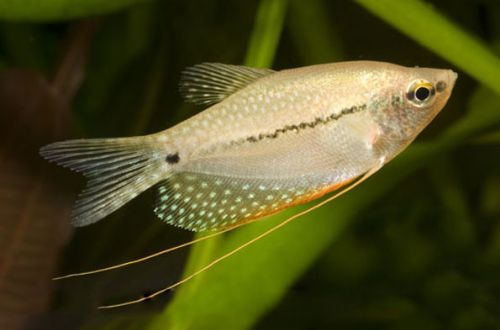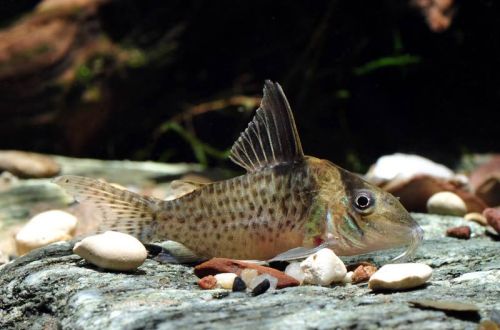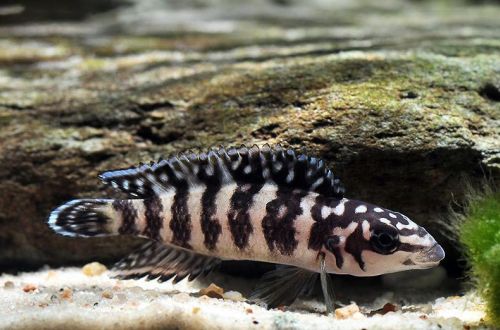
Pearl Gourami
The Pearl Gourami, scientific name Trichopodus leerii, belongs to the Osphronemidae family. Rightfully belongs to the most beautiful freshwater fish found in their natural habitat. The name of the fish came from the original mosaic pattern, consisting of numerous specks / dots, reminiscent of small pearls in color. Extremely hardy and unpretentious, a great option for beginner aquarists.

Some labyrinth fish can make various sounds (slightly growl, croak, clap, etc.) and this species is no exception. Most often, sounds can be heard during the spawning period or during skirmishes for territory between males. Whether these sounds have any practical meaning is unknown.
Contents
Habitat
Pearl Gourami comes from Southeast Asia. It was first discovered by European explorers in the middle of the 19th century. It lives on the territory of modern Thailand, Malaysia on the islands of Borneo and Sumatra. In recent decades, the wild population has declined significantly. However, the current situation does not threaten the aquarium fish market, since their mass production has been established in the Far East and Eastern Europe.
In nature, Gourami is found in lowland swamps with acidic water, in rivers and creeks with dense vegetation, small ponds and lakes. They feed on various crustaceans, insect larvae and zooplankton.
Description
The fish has an elongated oval shape, the body is somewhat compressed from the sides. The dorsal and anal fins are elongated, becoming pointed in males. The pelvic fins are filiform and extremely sensitive – this is an additional sense organ with which Gourami gets acquainted with the outside world. Like other representatives of the labyrinths, it has the ability to absorb atmospheric oxygen directly from the air, while swallowing it at the surface. In the oral cavity there is a special organ penetrated by numerous capillaries – the rudiments of the lungs.
The predominant body color varies from brownish to red-brown with numerous light speckles/dots, which are also found on the tail and fins. A brown lacy stripe stretches along the body, narrowing as it approaches the tail.
Food
All types of dry industrial feeds (flakes, granules) are accepted in the aquarium. Many manufacturers have products specifically designed for gourami. You can diversify the diet by adding bloodworms, mosquito larvae, as well as pieces of fresh vegetables (lettuce, spinach, cucumbers, etc.). Feed according to the instructions on the packaging in case of using specialized food. If other feeds are used, then 2 times a day. When adding meat products, feeding should be limited to once a day.
Maintenance and care
It is recommended to purchase a spacious aquarium of about 140-150 liters with a built-in lid. It allows not only to prevent accidental ingress of foreign objects, debris and dust into the water, but also contributes to the formation of an air layer with high humidity and temperature. Such a layer reduces the risk of damage to the labyrinth organ of fish during the ingestion of atmospheric air. The mandatory minimum set of equipment is as follows: filter, heater, aerator and lighting system. The filter should provide effective cleaning, but at the same time create as little water movement as possible.
In the design, give preference to large plants with a strong root system, the optimal location is along the side and back walls of the tank. Floating plants are welcome and provide additional shade. Place several hiding places, hiding places in the form of grottoes, snags or artificial objects (a sunken ship, a castle, etc.), and their number should not be less than the number of fish. The substrate is preferably dark, the size of the soil particles is any.
Social behavior
The most peaceful species among gourami, making it an ideal candidate for a small community of fish. They are shy, can hide behind shelters if they feel danger, they will hide in a new aquarium for the first time, they need time to adapt. As neighbors, you should select representatives of the same species or other calm fish of a similar size. Very small fish can be hunted as they are a natural source of food for them in the wild.
Sexual differences
The male is distinguished by a more slender appearance, a long pointed dorsal anal fin. During spawning, the chest of males turns red.
Breeding / breeding
The Pearl Gourami breeds easily in the home aquarium. During spawning, males build foam nests and arrange fights among themselves. But they are not of a violent nature, injuries are extremely rare, the fish connect with their mouths and push each other. If more than two fish live in the aquarium, then the presence of an additional tank (quarantine aquarium) is highly desirable so that the fry feel safe and are not eaten.
Spawning begins under a combination of the following conditions: the presence of dense plantations of root plants, lowering the water level to 15–20 cm, setting the temperature at 28°C and pH values close to 7.0, including meat products in the daily diet. After some time, the female begins to fill with caviar, and the male starts building a nest from bubbles, pieces of plants. When the construction is completed, the courtship period begins – the male swims near the female, inviting her to the nest, while he fills with color, spreads his fins. Adults can produce up to 2000 eggs, which are carefully moved to the nest, where they remain under the protection of the male until the fry appear.
Diseases
They are hardy and not whimsical, however, they require a high ambient temperature, in cold water they become susceptible to diseases. Read more about symptoms and treatments in the Aquarium Fish Diseases section.





